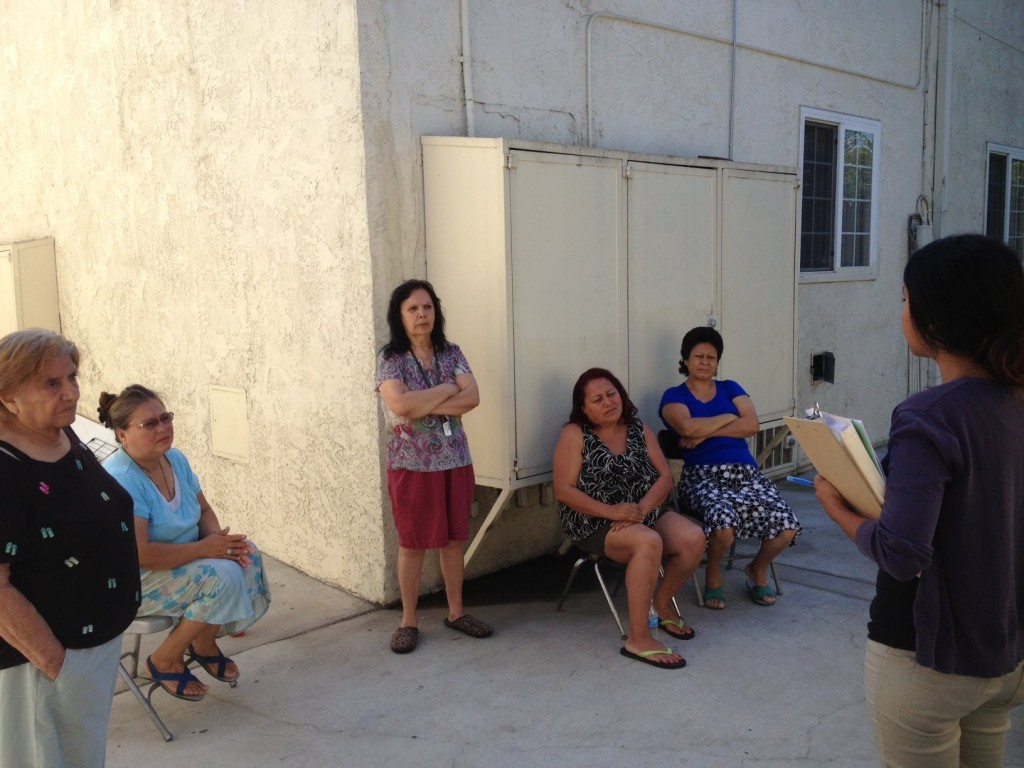
HUD tenants meet with CES Tenant Organizer Valerie Lizárraga at an apartment complex near USC in 2013 to discuss maintenance problems such as cracked-deteriorating bathroom flooring, missing bathroom vents, broken appliances and a cockroach infestation. | CES Facebook
By Lauren Day
Juana Vasquez has lived in her West Adams apartment for 20 years, and despite making regular requests for her refrigerator to be replaced, the appliance has been leaking water since the day she moved in.
“They never replaced nothing,” said Vasquez’s son, Carlos Rezabala, who helps his mother translate from Spanish. “It’s still the same… We’ve been asking for a long time.”
Vasquez and her son have had to settle for unhurried maintenance, making her living conditions “filthy,” said Rezabala.
He described his 82-year-old mother’s carpet as “disgusting.” He said the windows of the apartment, part of a senior housing complex subsidized by the city, have broken from age. But the property managers “don’t want to change, they don’t want to replace nothing,” he said.
Carlos Aguilar, from the Coalition for Economic Survival, said property managers of rent-controlled or affordable housing often take advantage of their tenants. Senior citizens are among the most vulnerable, he said, “because of their age and lack of knowledge and awareness of what their rights are.” So are people from “marginalized or ignored communities,” such as South L.A.
Aguilar said he saw one woman forced out by “constructive eviction” – a legal term meaning the tenant was obligated to leave because her residence did not meet basic standards.
“Owners refused to do the repairs and maintenance,” said Aguilar. “The property got to such bad condition that the place was deemed uninhabitable.”
His coalition organizes Los Angeles tenants in rent-controlled and subsidized housing that face harassment, illegal evictions, illegal rent increases and slum housing conditions. CES also helps to educate tenants about their rights and encourages them to make sure those rights are honored by their landlords. The organization is also working on programs to preserve affordable housing units in the City of Los Angeles.
The looming threat for seniors, if these battles are not fought, is homelessness, advocates said.
In 2013, the Los Angeles Homeless Services Authority counted a total of 2,300 homeless people in District 8 – nearly 775 people above the L.A. City average. South L.A. as a whole had the highest number of homeless senior citizens – roughly 950 people. In contrast, East Los Angeles had the least number of homeless seniors, totaling about 185. The organization does not keep data on the number of seniors who became homeless as a result of evictions.
Vasquez, the tenant with the leaky refrigerator, lives in HUD-subsidized senior housing in District 8. But that’s no reason for the property to be substandard, Aguilar said, adding: “It has everything to do with who manages and who owns that property.”
Vasquez made little headway with the latest property manager of her apartment complex. Her kitchen light was out for more than a year before the building’s management fixed it, said her son.
Affordable housing is crucial in areas like Vasquez’s where the average annual salary is $33,360, according to the city’s 2013 Economic Report – nearly $24,000 below the city average. The median rent where Vasquez lives was $1,086 in 2014, whereas the average rent in Los Angeles was $1,463, according to the RED Capital Group, a lending institutions specializing in housing.
Most buildings built before 1978 in Los Angeles are rent-controlled properties, including many South L.A. neighborhoods.
Current tenants of rent control properties are only subject to limited annual rent increases, monitored by the city. But illegal rent increases still occur “because if a tenant doesn’t know,” the person is “never going to challenge it,” said Aguilar.
Landlords must comply with the 14 eviction requirements of the L.A. Rent Stabilization Ordinance. However, some conduct constructive evictions, which are not legal, but rather “sheer harassment, intimidation or lack of repairs and maintenance,” Aguilar said. Tenants in these circumstances are often “so frustrated that they just move out.”
Rezabala said he is not willing to give up the fight for his mother, adding: “They’re abusing us, that’s what they’re doing.”
Some housing rights attorneys believe their clients are targeted just because they are easy to evict. According to Nick Levenhagen, an attorney at Bet Tzedek Legal Services, tenants in Section 8 housing that is subsidized by the city typically “hate to complain” because they fear losing their housing.
For Section 8, landlords generally have the legal right to decide whether they want to accept Section 8 vouchers for the following year. However, in rent-controlled properties, landlords must comply with the “just cause” eviction requirements of the Rent Stabilization Ordinance when terminating a Section 8 tenancy.
But landlords often try to work around that regulation. The daughter of an elderly couple with a Section 8 subsidy, who asked to remain anonymous, said that the building owners told her parents they did not want to accept Section 8 vouchers any more, aiming to remodel and eventually increase the rent. The move was illegal, according to Levenhagen, the family’s attorney.
The couple eventually agreed to a settlement: They would move after 17 years of living at the apartment in exchange for a payout from the landlord.
Wrongful evictions put low-income seniors at risk of homelessness, according to Levenhagen.
“Unless you have an advocate who represents you, then you’re just going to go,” he said.
Such was the case for Rezabala and his mother, who are grateful for Carlos Aguilar’s help. “There was nobody… until we found Carlos,” said Rezabala.
Los Angeles does not posses enough affordable housing to accommodate all elderly residents on fixed incomes, according to Aguilar. It’s impossible for seniors whose sole income is social security or disability checks to make market price rent. “You end up having elderly homeless people,” he said. “That’s a side of the story that doesn’t get discussed.”
Like Intersections on Facebook, follow us on Twitter and sign up for the Newsletter to stay in the loop on news and views from South L.A.









 Jasmyne Cannick
Jasmyne Cannick Los Angeles Neighborhood Housing Services, Inc.
Los Angeles Neighborhood Housing Services, Inc. Fair Housing Foundation
Fair Housing Foundation Broadway South Neighborhood Revitalization Project
Broadway South Neighborhood Revitalization Project Housing Rights Center
Housing Rights Center Los Angeles Community Action Network: L.A. Right to Housing Collective
Los Angeles Community Action Network: L.A. Right to Housing Collective




